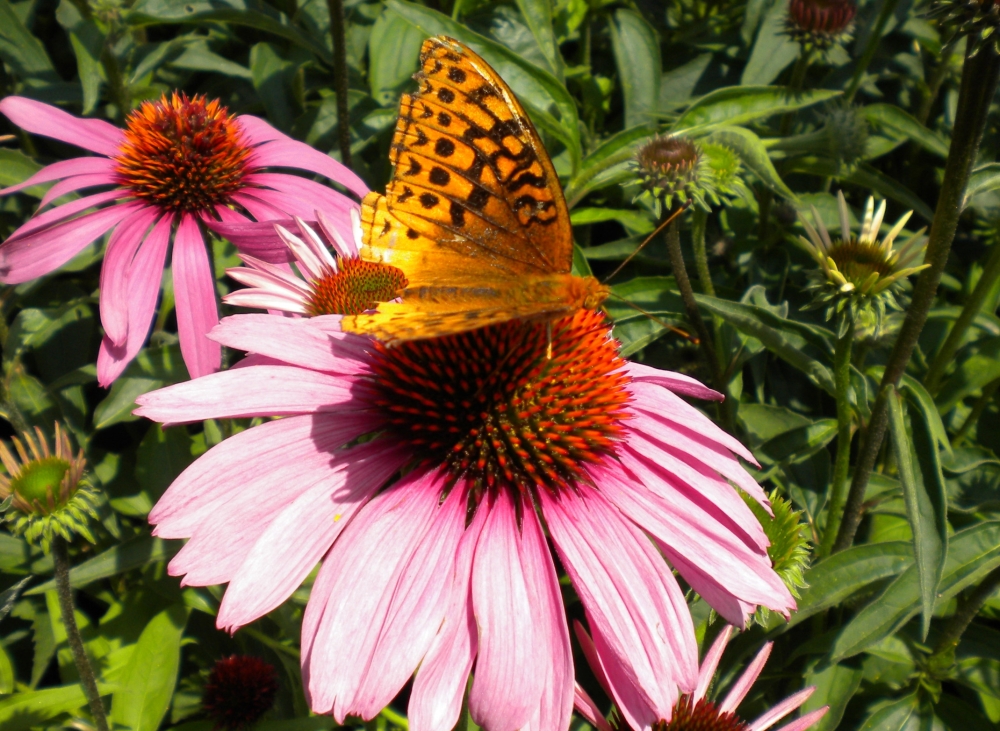My garden seems particularly ill suited to growing coneflowers (Echinacea purpurea, below). These are tough native perennials that require a mostly sunny and well drained location. They are not particular about soil, and need little care. Through the years I’ve planted a handful or two, mindful to provide a dry, sunny environment, but eventually they fade and disappear. There are multiple reasons for this. Some, I think, is the fault of plant breeders rushing less than vigorous cultivars to market, and some of the fault is mine.
A number of coneflowers have been introduced in recent years in a delightful range of colors, but many gardeners have been disappointed in their performance, with plants lasting only a year or two. I suppose that in the race to bring new plants to market there has been a lack of long term testing in a variety of climates. I suspect that the success rate for new introductions from some well known breeders is quite poor, and it seems that there’s a need for one group or another to keep score to protect gardeners from poor plants that are aggressively marketed.
I’m in a poor place to judge good plants from bad since I have trouble discerning which coneflowers lack vigor, and ones that have fallen victim to encroaching shade or overzealous neighbors. Too often the sunny spots where I’ve planted something are not sunny for long, so there’s no surprise when a plant finally perishes. ‘Tomato Soup’ (above) flourished for several years until the nearby Seven Son tree spread enough to shade the coneflower. It slowly declined, and then it was gone.
I’ll take the blame for that one, and for ‘Coconut Lime’ that has hung on valiantly despite an overhanging ‘Cherry Dazzle’ dwarf crapemyrtle. One lone stem remains from the once bushy coneflower, and this winds from beneath the crapemyrtle to find some space to push through a large leafed hosta. There is one flower in early September, and another bud, but I fear that this is the last gasp and next year it will disappear for good.
I’ve no reason to be upset by the coneflower’s dilemma. When the area was planted everything had plenty of space, but plants grow, and the only chance the smaller coneflower had was to be transplanted to a spot with more sun and space. I could still do this, but where? I’ve considered clumping a few of the daylilies a bit closer together, and this would open a sunny spot. Or…., there are a bunch spaces where the last remaining coneflower could be jammed into, but with my limited attention span it’s unlikely I’ll remember. So, this will probably be the last of the coneflowers, and I’ll get along to plants that are better suited to this garden.
While browsing the “gardening” topic, I ran across your post which IMMEDIATELY caught my eye. I’ve NEVER successfully grown a coneflower in MA or FL and have never understood why! I’m a master gardener and have little to no trouble with anything, whether grown from seed or transplanting, so my lack of success with coneflowers quite frankly shocks me!
Anyway, just thought I’d check in with a comment. I’m off to look through the rest of your blog!
Hi Dave,
I leave nearby in Culpeper, Va and have had a lot of trouble with caterpillars devouring my coneflowers this year. It stripped one plant down to a few leaf strings before I saw it. This is a first as I’ve grown them for years and they seemed bombproof; given adequate sun. I’ll try to i.d. the next evil chomping caterpillar I find.
Oh, and the fancy new coneflowers: zero luck overwintering those dudes. I may try again but they are mighty pricey for an “annual”.
I’ve had more caterpillars and other chewing insects this summer than I can recall. This morning there’s something that looks like a grasshopper chewing on one of the toad lilies that’s in full sun. I saw it a few weeks ago also, and since it hasn’t done much damage I’ll leave it alone. I noticed that the Golden Chain tree that was nearly stripped bare by caterpillars is flushing some new foliage.so there’s no doubt it will be fine. So long as a plant is not in imminent danger I’ll usually not disturb chewing insects, though I’ve had just about enough of the lacebugs that invade the pieris varieties.
There’s a lot to be said for the tried and true basic plants. I prefer to let others spend their hard earned money to trial new introductions, but too often enthusiasm overrules my judgment.